Innovations in Smartwatches: Measuring Blood Oxygen Levels
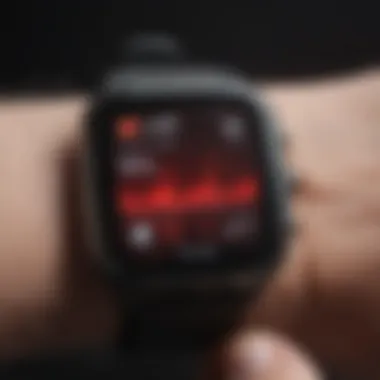
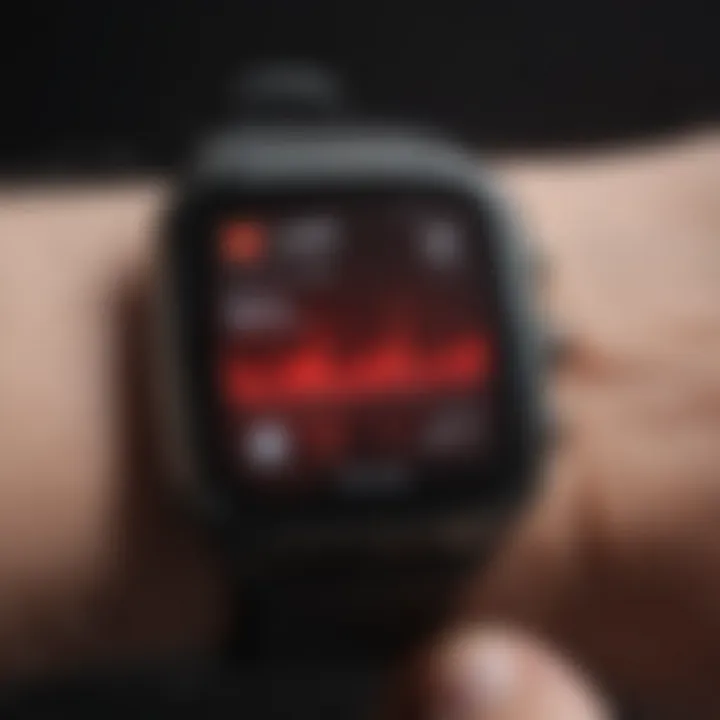
Intro
The intersection of technology and health has become increasingly significant. Smartwatches have emerged as powerful tools in personal health monitoring. Among various features, the ability to measure blood oxygen levels stands out. This innovative functionality has profound implications, not just for individual users but also for the broader healthcare landscape.
Understanding how smartwatches measure blood oxygen levels requires some knowledge of the scientific principles and technological advancements behind these devices. The concept of blood oxygen measurement goes beyond mere novelty; it embodies a substantial leap forward in preventive health strategies.
As we dive deeper, this article will outline key components of blood oxygen monitoring technology, explore its impact on personal health insights, and consider the potential applications in clinical settings. We aim to provide a thorough exploration of this innovation, ensuring an insightful perspective for students, researchers, educators, and professionals in the field.
Foreword to Smart Watches and Health Monitoring
Smart watches have brought significant changes to personal health management. The fusion of technology with wearables allows users to monitor various health metrics conveniently. This section examines the evolution of wearables, as well as their relevance in today's health monitoring landscape.
Evolution of Wearable Technology
Initially, wearable technology like fitness trackers focused on basic metrics such as step count and calories burned. As the technology advanced, these devices evolved to incorporate more complex features. Companies like Fitbit and Apple started to include heart rate monitors and GPS tracking, significantly enhancing their capabilities. Today, smart watches can track a variety of health metrics, including blood oxygen levels.
The evolution also reflects a growing consumer demand for health-centric features. Users want devices that not only track their activity but also offer insights into their health. For instance, the introduction of the Apple Watch Series 6 marked a turning point with the integration of blood oxygen monitoring. Such innovations illustrate the shift towards comprehensive health management solutions.
Importance of Health Monitoring Devices
Health monitoring devices play a critical role in preventive health care. They empower individuals to take control of their well-being by providing real-time data. Wearable devices, particularly smart watches, enable users to track their health metrics continuously. This capability can lead to early detection of potential health issues.
- Continuous Tracking: These devices provide ongoing monitoring rather than point-in-time snapshots. This is essential for understanding trends in one's health.
- Data-Driven Decisions: Users gain insights into their health patterns, helping them make informed lifestyle choices.
In the realm of telemedicine, the importance becomes even more evident. Smart watches can send crucial data to healthcare professionals, facilitating remote monitoring. This helps doctors make better-informed decisions about patient care.
"The integration of technology in health monitoring is not just a trend; it's a necessary evolution toward a more informed patient population."
The continual improvement of wearables indicates their increasing relevance in modern health care. As people become more health-conscious, the demand for sophisticated monitoring devices will likely rise. This growth will ultimately lead to better health outcomes for many.
Understanding Blood Oxygen Levels
In this section, we will delve into the essential topic of blood oxygen levels. This aspect is vital for understanding how smartwatches equipped with health monitoring technologies can provide insights into our overall well-being. Blood oxygen saturation, represented as SpO2, is a key metric that indicates how well oxygen is being transported throughout the body. No matter one’s age or health status, keeping an eye on blood oxygen levels can offer important clues about respiratory health, fitness levels, and potential medical issues.
What is Blood Oxygen Saturation?
Blood oxygen saturation refers to the amount of oxygen bound to hemoglobin in the blood. It is usually expressed as a percentage. A normal range for healthy adults is typically between 95% to 100%. Values outside this range can signal issues such as respiratory distress or circulation problems. This measurement is crucial for both average individuals and patients with pre-existing conditions. Tools such as pulse oximeters, commonly found in smartwatches, allow for non-intrusive measurement of this key health indicator.
Significance in Health Monitoring
Monitoring blood oxygen levels has significant implications for different aspects of health. Here are a few reasons why it holds importance:
- Early Detection of Problems: Low levels of blood oxygen can indicate conditions like sleep apnea, asthma, or other respiratory issues that require immediate attention. Being aware helps seek timely medical intervention.
- Athletic Performance: For athletes, understanding blood oxygen saturation during training can help optimize performance and recovery. It allows for adjustments in training intensity to prevent overexertion or injury.
- Remote Monitoring: In the context of telemedicine, smartwatches can facilitate the monitoring of patients' health from home. This reduces the frequency of in-person visits for individuals with chronic conditions.
Blood oxygen monitoring through smartwatches represents a convergence of convenience, technology, and healthcare, allowing for real-time awareness that can empower individuals to take control of their health.
Technological Components of Smart Watches
Understanding the technological components of smart watches is essential to grasp how they effectively monitor blood oxygen levels. These devices have evolved significantly, integrating advanced features that cater to personal health insights. At the core of this innovation are the sensors and the data processing systems that work together to provide accurate health information.

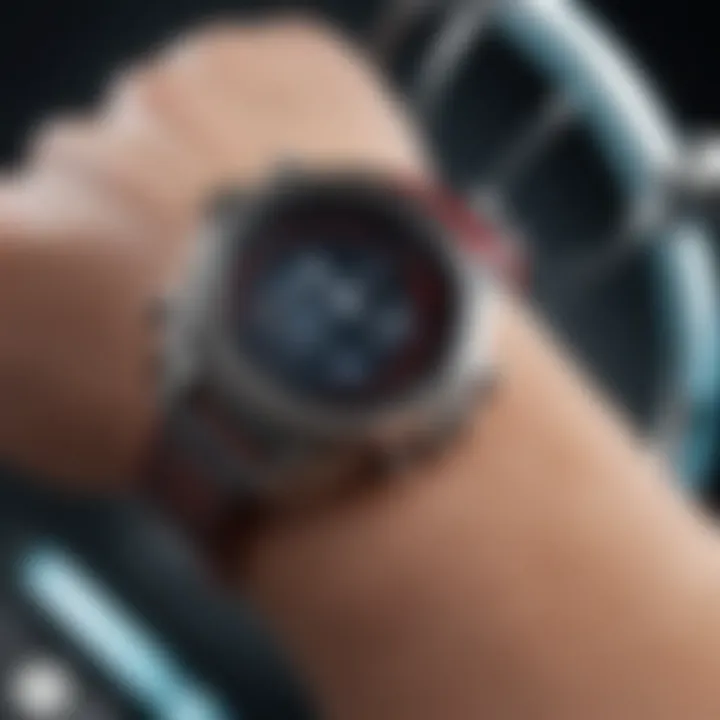
Sensors for Blood Oxygen Measurement
The sensors used in smart watches for measuring blood oxygen levels are pivotal. These sensors are primarily based on the principle of photoplethysmography (PPG), a method that employs light to detect changes in blood volume. When light is shone onto the skin, the sensor can measure how much light is absorbed or reflected. This variation occurs due to the pulsatile nature of blood flow.
Some notable types of sensors include:
- Red and Infrared Light Sensors: These sensors emit wavelengths of light that penetrate the skin and measure oxygen saturation levels in the blood. The ratio of absorbed light correlates with oxygen content.
- Accelerometers: They can track movement, enhancing the accuracy of readings by eliminating interference from non-stationary conditions.
Smartwatch manufacturers, including Apple, Garmin, and Fitbit, have made strides in refining these sensors. The precision of blood oxygen measurement relies heavily on the quality and consistency of these sensors. Environmental factors, such as skin color, temperature, and movement, can affect the accuracy of the readings.
Data Processing and Interpretation
Once the sensor collects data, the information needs processing for interpretation. This step is crucial, as raw data lacks context and clarity. Smart watches utilize algorithms to analyze the data collected from the sensors, transforming it into actionable health insights.
- Algorithms: These are the backbone of smart watch functionality. They take the data from sensors and interpret it in real-time, estimating blood oxygen saturation levels reliably.
- Machine Learning: Some advanced models use machine learning techniques to improve readings over time. These algorithms can learn user patterns and refine their accuracy based on historical data.
- User Interface: A significant part of the interpretation process is how the results are displayed. The interface must convey complex analysis in an understandable manner, highlighting trends and alerts for the user.
Effective data processing ensures that users receive timely and accurate blood oxygen readings. This timely information supports users in personal health monitoring, allowing them to take preventive measures if necessary.
"The integration of advanced sensors and smart algorithms in smart watches marks a significant advancement in health monitoring technology, particularly for blood oxygen levels."
With the evolution of these technological components, smart watches are not only enhancing personal health management but also paving the way for broader applications in healthcare.
How Smart Watches Measure Blood Oxygen
Smart watches that measure blood oxygen levels represent a fascinating convergence of health technology and consumer electronics. The ability to monitor blood oxygen saturation (SpO2) offers individuals critical insights into their health. It can indicate physical fitness, respiratory conditions, and overall well-being. Understanding how smart watches achieve this functionality is crucial, not just for users, but also for healthcare professionals who may integrate this data into patient care.
The Principle of Pulse Oximetry
Pulse oximetry is the underlying principle of how smart watches measure blood oxygen levels. This non-invasive technique generally uses a light sensor to detect the color of blood as it flows through the capillaries. Specifically, it measures the absorption of light by oxyhemoglobin and deoxyhemoglobin, allowing for the calculation of the amount of oxygen in the blood.
This process involves:
- Light Emission: The device emits two wavelengths of light, usually red and infrared, into the skin where the blood vessels are located.
- Light Detection: Sensors within the smartwatch measure the amount of light that passes through the skin and is reflected back.
- Data Interpretation: The smartwatch’s internal algorithms analyze this data to provide a real-time estimate of oxygen saturation.
The accuracy of pulse oximetry can be affected by several factors, including skin pigmentation, temperature, and motion. Despite these challenges, improvements in sensor technology are enhancing the reliability of these measurements.
Integration into Wearable Devices
Integrating pulse oximetry into smart watches involves combining multiple technologies and component designs. Here are some critical aspects of this integration:
- Sensor Miniaturization: Advances in micro-electromechanical systems (MEMS) allow for smaller, more efficient sensors suitable for everyday wear without sacrificing performance.
- Power Efficiency: Since smart watches are often used throughout the day, low-power consumption components are vital. Innovations in battery technology help ensure that users can obtain blood oxygen readings without frequent recharging.
- Software Algorithms: Modern smart watches come with sophisticated software that enables real-time data analysis, user notifications, and storage of health metrics for long-term tracking.
It is important to consider how these integrations not only improve function but also user experience. Users are more likely to keep track of their health data if the process is seamless and intuitive. Thus, the merge of hardware and software must focus on usability while delivering precise measurements.
The dynamic integration of pulse oximetry technology into smart watches revolutionizes health monitoring, making it accessible for everyone and aiding in early detection of health issues.
Applications of Blood Oxygen Monitoring
In recent years, blood oxygen monitoring has become an essential function integrated into smartwatches. The ability to measure blood oxygen levels can provide significant insights not just for everyday health monitoring but for various applications that span personal use to clinical settings. Smartwatches designed with this functionality play a crucial role in transforming health perceptions and practices. They empower individuals to take ownership of their health and enhance the capabilities of healthcare professionals.
Personal Health Insights
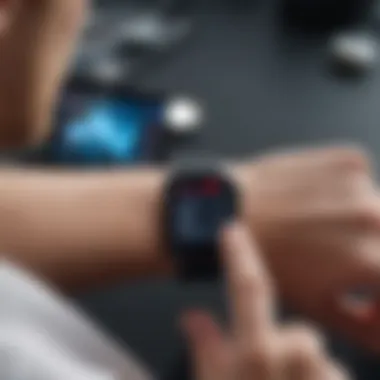
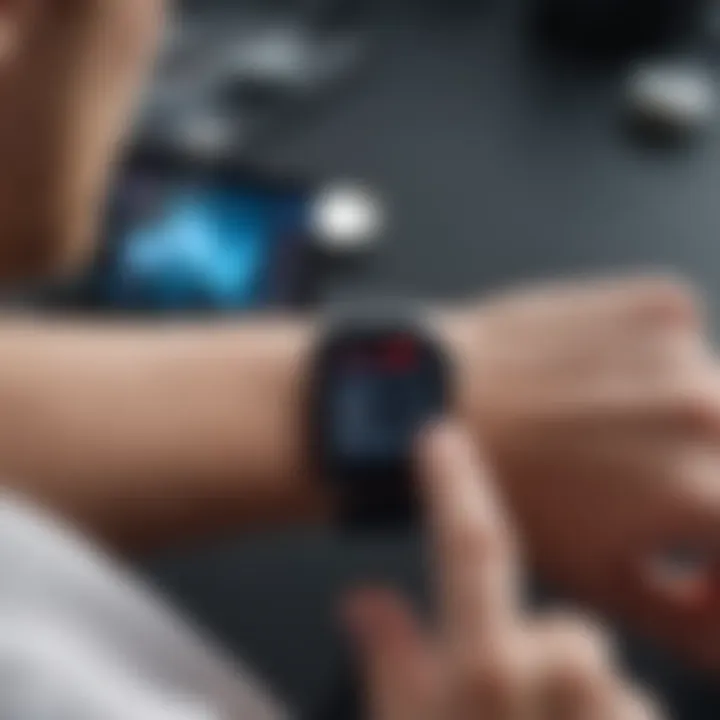
Smartwatches with blood oxygen monitoring deliver immediate, actionable data. Users can track their oxygen saturation throughout the day, providing insight into their overall respiratory health. Regular monitoring helps users detect potential health issues early. For instance, a sudden drop in blood oxygen levels might indicate respiratory problems or other underlying conditions. Thus, the data acts as an essential tool for personal health management.
Users can establish trends over time. This means those with chronic conditions, such as asthma or COPD, can better manage their health by understanding how their oxygen levels fluctuate. Moreover, notifications and real-time updates can prompt immediate action, leading to timely interventions. Overall, the convenience and accessibility of real-time data encourage a proactive approach to health and wellness.
Monitoring for Athletic Performance
Athletes and fitness enthusiasts have embraced blood oxygen monitoring in training regimens. High-altitude training or interval workouts can significantly benefit from tracking oxygen levels. Understanding how the body responds to various levels of exertion helps athletes optimize their performance.
Using this data, athletes can:
- Assess their oxygen efficiency during various activities.
- Adjust training intensity based on their oxygen saturation levels.
- Monitor recovery rates post-exercise for enhanced performance.
This monitoring becomes even more crucial during competitive events, where maintaining optimal performance is essential. Whether during training or competitions, real-time feedback improves strategic planning and overall outcomes.
Clinical uses in Telemedicine
In clinical settings, blood oxygen monitoring has taken on new relevance, especially within telemedicine. Healthcare professionals can remotely monitor patients' health through smartwatches, reducing the need for in-person visits. This capability is particularly beneficial for patients who may have mobility issues or lack access to healthcare facilities.
For instance, patients with chronic respiratory diseases can have their oxygen saturation monitored continuously, allowing doctors to make informed decisions without requiring patients to leave their homes. This ongoing data stream can facilitate:
- Early identification of deteriorating health conditions.
- Adjustment of medication based on real-time readings.
- Customized care plans tailored to individual needs.
With the emergence of telemedicine, integrating blood oxygen monitoring into smartwatches not only enhances patient care but also fosters a greater understanding of one’s health within a clinical context.
These applications underscore the value of blood oxygen monitoring, bridging personal health tracking and clinical healthcare in transformative ways.
Comparative Analysis of Available Smart Watches
In the rapidly evolving landscape of health monitoring, smart watches that measure blood oxygen levels have emerged as vital tools for both personal and clinical use. This comparative analysis aims to shed light on various models currently available in the market, allowing consumers to make informed decisions based on key performance indicators. Understanding the strengths and limitations of each device enhances users’ ability to select the watch that best fits their specific needs for health tracking.
Leading Brands and Models
Several leading brands have integrated blood oxygen monitoring into their smart watches. The following are notable examples:
- Apple Watch Series 7: Recognized for its sophisticated design, it includes comprehensive health tracking features, including blood oxygen monitoring. The Apple ecosystem also syncs seamlessly with other devices, allowing for integrated health metrics.
- Samsung Galaxy Watch 4: This model boasts an advanced health suite that provides accurate blood oxygen readings along with a host of fitness tracking features. It is particularly favored by users of Android devices, thanks to its harmonious interaction with the Android ecosystem.
- Fitbit Charge 5: Although primarily a fitness tracker, the Charge 5 incorporates blood oxygen monitoring capabilities. It is widely used for its user-friendly interface and strong emphasis on wellness.
- Garmin Forerunner 245: This smartwatch is targeted at serious athletes and includes precise blood oxygen saturation measurement alongside advanced running metrics, catering to performance-focused individuals.
Each of these devices offers unique functionalities and design integrated with blood oxygen monitoring. Considering factors like brand reliability, user preference, and compatible ecosystems is critical when choosing a smartwatch.
Performance Metrics and Accuracy
Performance metrics are fundamental when analyzing smart watches for blood oxygen monitoring. Some key aspects to consider are:
- Accuracy of Readings: Users expect precise measurements. Models like the Apple Watch Series 7 and Samsung Galaxy Watch 4 are known for their accuracy, minimizing errors that can lead to misunderstandings about one’s health status.
- Battery Life: Prolonged battery life is essential, as continuous monitoring can lead to battery drain. Devices such as the Fitbit Charge 5 have been reported to offer exceptional battery performance, even with continuous sensor use.
- Ease of Use: The user interface should be intuitive. Watches with complicated navigation can frustrate users, particularly when monitoring critical health metrics. Simplicity in design often enhances user experience.
- Integration with Health Apps: The ability to sync with health applications is crucial. Smart watches that support third-party fitness and health apps provide users with a comprehensive view of their health data over time.
"The effectiveness of blood oxygen monitoring can greatly influence the user's health decisions, making the choice of smartwatch an important consideration."
In summary, the comparative analysis provides essential insights into various available models, demonstrating the importance of performance metrics and brand reliability. As technology continues to advance, it is vital for potential users to remain informed about their options in the realm of smart watches.
Challenges in Blood Oxygen Monitoring
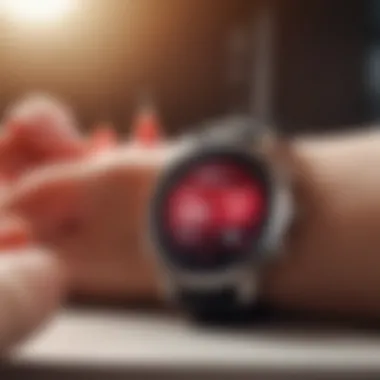
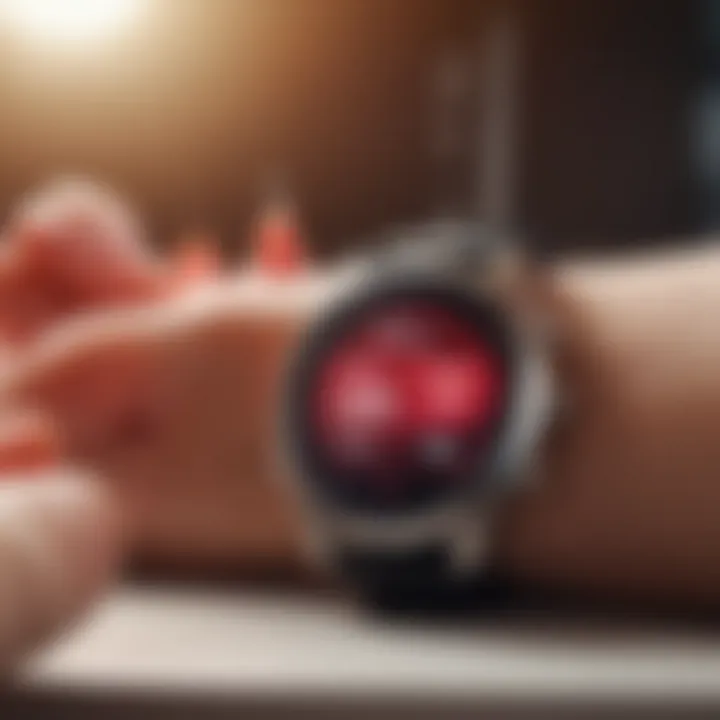
Monitoring blood oxygen levels is crucial, especially in an era when personal health tracking has gained significance. Smart watches that provide this capability must navigate several challenges to ensure reliable assistance for users. These challenges stem from both technological limitations and the variability of physiological responses. Understanding these factors is essential for developing better health monitoring solutions.
Limitations of Current Technology
The technology used in smart watches to measure blood oxygen levels is still evolving. While devices equipped with pulse oximeters offer functionality, there are inherent limitations. The sensors often depend on infrared light and photodetectors to gauge changes in blood flow and oxygen saturation. However, these sensors can be sensitive to factors such as skin color, tattoos, or even poor placement on the wrist. Without adequate calibration and refinement, these aspects can impact the measurement accuracy, leading to unreliable data.
Moreover, many devices may lack the sophistication required to deliver precise results in varied environmental conditions. High altitudes or extreme temperatures can affect how well a sensor performs, causing discrepancies in readings. Therefore, relying solely on smartwatches for critical health decisions may not be advisable at this stage in technology.
Variability in Readings
In addition to limitations in the sensors themselves, variability in individual physiology adds another layer of complexity. Each person's unique biology can influence blood oxygen levels. Factors such as age, fitness level, and underlying health conditions can create wide variances in results. For instance, a highly conditioned athlete may have different baseline readings compared to someone who is less active.
Furthermore, external influences such as exercise and stress can cause temporary fluctuations in oxygen saturation. These variations make it challenging to interpret data consistently. Users may not fully grasp when a reading reflects a transient change versus a more significant health issue. Consequently, understanding how to read and respond to this variability becomes crucial.
"Health monitoring through smart technology must be matched with user knowledge. Awareness about capabilities and limitations leads to better health outcomes."
Future Trends in Smart Watches and Health Monitoring
The landscape of smart watches is continuously evolving. Health monitoring, particularly blood oxygen monitoring, stands out as a significant aspect of this transformation. As technology advances, modern devices not only track vital signs but also analyze and interpret this data to provide actionable insights. This section investigates the upcoming trends in smart watches, emphasizing their relevance to health monitoring.
Emerging Technologies
Emerging technologies are critical in enhancing the capabilities of smart watches trained on health metrics. Developments in sensor technology are paving the way for more accurate and real-time health monitoring features. For instance, the application of photoplethysmography (PPG) has improved the precision of blood oxygen level readings. Additionally, advancements in miniaturization allow for the incorporation of sophisticated sensors in smaller devices without compromising accuracy.
Furthermore, artificial intelligence is becoming an integral part of smart watch functions. AI algorithms analyze vast amounts of data collected from users. This analysis can identify patterns, predict health issues, and provide personalized health recommendations. Machine learning models are particularly useful for adapting to individual users over time, enhancing the relevance of health insights.
Integration with Other Health Metrics
Smart watches are increasingly designed to integrate various health metrics, creating a multidimensional view of health. Combining blood oxygen data with information from heart rate monitors, sleep trackers, and activity logs provides users with a comprehensive profile of their health status. Such integration enables more accurate assessments and supports preventive health care.
For example, by monitoring blood oxygen levels alongside heart rate variability, users can gain deeper insights into their cardiovascular health. Similarly, when sleep data is included, the smart watch can help identify how oxygen levels affect sleep quality and overall recovery.
The versatility of these devices increases their usage beyond personal fitness to clinical settings. Healthcare providers can utilize aggregated data from patients' devices to make informed decisions about their health, facilitating remote monitoring and reducing the need for in-person consultations.
Smart watches of the future will not only tell you your stats; they will help you understand them in a context that is unique to you, supporting better health management and well-being.
The trends indicate that smart watches will become essential tools not only for individual users but also for healthcare professionals seeking to deliver enhanced treatment options. As a result, the growing synergy between emerging technologies and the integration of health metrics positions smart watches as vital assets in modern health management.
The End and Final Thoughts
The advancements in smartwatch technology, particularly those that measure blood oxygen levels, represent a significant leap in health monitoring. These devices are not merely accessories; they hold the potential to transform personal healthcare. Smartwatches can help users track their blood oxygen saturation, providing important data that can signal health issues before they escalate. Monitoring oxygen levels is critical for various populations, including athletes, the elderly, or those with pre-existing conditions like respiratory diseases.
The Role of Smart Watches in Modern Health Management
Smartwatches serve a pivotal role in modern health management. By integrating advanced sensors and algorithms, these devices allow individuals to oversee their well-being conveniently. Users can observe fluctuations in their oxygen levels, which can indicate changes in their health status.
For instance, during exercise, monitoring blood oxygen saturation can help athletes optimize their performance by understanding whether they are training efficiently or overexerting themselves. Additionally, these readings can help in managing chronic conditions, where consistent tracking can be vital for timely interventions.
Furthermore, data shared with healthcare providers can enhance patient-provider communication. This collaboration leads to more personalized care plans, refined health assessments, and proactive interventions.
Continued Research and Development
As the technology underlying smartwatches becomes more sophisticated, ongoing research remains crucial. Manufacturers continually refine their models to improve accuracy and reliability in measuring blood oxygen levels. Telehealth is also gaining traction, where smartwatches play a role in remote patient monitoring, enabling healthcare providers to conduct assessments without requiring physical visits.
Future trends likely involve deeper integrations with other health metrics, enhancing the overall value of a health tracking solution. Researchers are investigating how to better utilize artificial intelligence and machine learning in interpreting collected data. By doing so, they aim to create systems capable of predicting health issues before they become critical, ultimately reducing healthcare costs and improving patient outcomes.
In summary, smartwatches equipped with blood oxygen monitoring capabilities are reshaping the landscape of personal and clinical health management. As technology progresses, so will our understanding of health and wellness.



